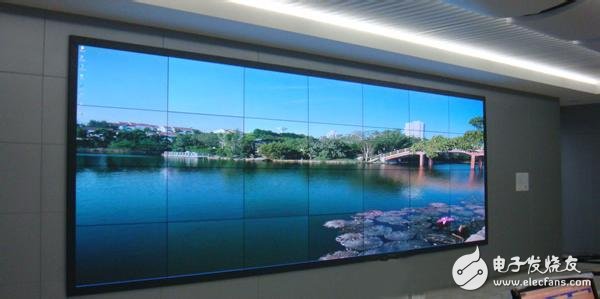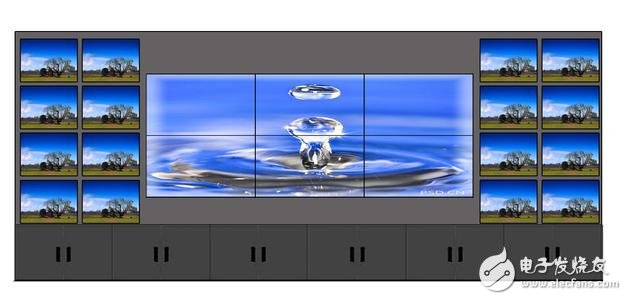With the improvement of information technology, people are increasingly demanding visual appreciation. "Visual impact" has become a standard for people to judge display performance. Visual impact comes not only from a clear picture, but also from an oversized picture. In order to meet this demand, large-screen splicing came into being. In addition, edge fusion technology based on projection technology is also available for large screens. From the current situation, in the application of super-large images, the various technologies are "all in each eye" and play various advantages in different fields.

Large screen splicing system
At present, the relatively common large-screen splicing system is generally divided into three main types according to the working mode of the display unit, namely, LCD display unit splicing, PDP display unit splicing, and DLP rear projection display unit splicing. The former two belong to the flat panel display unit splicing system, and the latter belong to the projection unit splicing system.
Plasma large screen splicing system
PDP (Plasma Display Panel), which is a plasma display. PDP is a display technology that uses gas discharge and works like a fluorescent lamp. It uses a plasma tube as a light-emitting element. Each plasma tube on the screen corresponds to one pixel. The screen uses glass as a substrate, and the substrates are separated by a certain distance to form a discharge space. The discharge space is filled with a mixed inert gas such as helium or neon as a working medium, and a metal oxide conductive film is coated on the inner surface of the two glass substrates as an excitation electrode. When a voltage is applied to the electrode, a plasma discharge phenomenon occurs in the mixed gas in the discharge space, which is also called a plasma effect. The plasma discharge generates ultraviolet light, and the ultraviolet light excites a fluorescent screen coated with red, green and blue phosphors, and the fluorescent screen emits visible light to reveal an image.
PDP unit splicing has the advantages of bright color, high contrast and high brightness, and it also has its own insurmountable shortcomings. Due to the large amount of electricity and heat generated, plasma can cause serious burns and is not suitable for long-term static display monitoring. And after the PDP unit is used for splicing, the whole machine heats up higher, which makes the device easy to burn. In addition, the current market price of plasma splicing curtain wall is relatively high, generally the price of one square meter is as high as 100,000. Today, low carbon and energy saving have become the mainstream trend. For most ordinary users, plasma splicing is obviously not the best choice.
Despite the many shortcomings, the bright color and high brightness of the plasma make the display effect of the screen have outstanding advantages, which makes plasma splicing become the darling of some exhibition activities. In addition, plasma is also preferred for government agencies that require high picture quality. However, from the overall market share, plasma splicing is at a complete disadvantage, and the development potential of plasma splicing is limited in terms of the development trend of the entire industry. According to some industry insiders, the industry is currently a “chicken rib industry†and will definitely be replaced in the future.

LCD LCD splicing
The so-called LCD liquid crystal large-screen splicing is a splicing screen body that realizes large-screen display effect by splicing control software system by means of splicing of LCD display unit. LCD LCD splicing is currently represented by Samsung's DID in South Korea. Although there are SHARP, LG, NEC and other brands in the splicing market, DID stands out in LCD flat panel splicing technology with its excellent cost performance.
LCD splicing has the advantages of thin thickness, light weight, low energy consumption, long life, no radiation, and its fine picture and high resolution. The excellent performance of various key performance indicators has made it the mainstream of development and the prospect is promising. As a splicing display terminal, although the LCD has the above advantages, as a splicing display unit, its disadvantage is also fatal: that is, its seams are currently large, and the largest among the three spliced ​​display units, so many users have to bear with pain.
As far as the current development trend is concerned, as a new technology, although LCD splicing has serious defects, most people in the large screen splicing industry still have high hopes for it. Nowadays, the development needs of large-screen splicing systems have become increasingly clear - that is, the splicing walls can display multiple high-definition dynamic images without restriction. Among them, the display unit needs to be further developed, high-definition, fine seam, light and low power consumption is the development direction; and among the three display units, only LCD can bear this responsibility. At present, Samsung has launched a splicing screen with a comprehensive seam of 7.3mm. This major breakthrough not only brings huge impact to MPDP and DLP splicing, but also makes it more meaningful for the further popularization of LCD splicing.
Focusing on the low power consumption, long life and high-definition characteristics of LCD splicing, it is favored in the field of security monitoring. From the current application trend of the Chinese market, it has become a trend to use the LCD large screen to establish a monitoring and command system in important parts such as national key transportation, transportation hubs and large venues. Especially in the field of security monitoring, LCD large screen system splicing wall is gradually replacing the traditional CRT, DLP splicing wall, becoming the preferred successor of professional security monitoring splicing large screen. In addition, as a display terminal for digital signage, the industry is also favored for LCD splicing.
The frequent school violence incidents this year have pushed security to the forefront, which has largely opened up the market gap for LCD splicing. At present, people in the industry generally believe that with the popularization of security, LCD splicing will usher in a field of security surveillance. Recently, the security giants in China's security industry, after acquiring the core technology of LCD display technology, have abandoned the Jiuding business unit that has developed and expanded its core technology products in China. This may be the development of the market trend. Support.

Network Accessories,Wifi Adapter,Fiber Optic Network Components,Splitter Fiber Optic
Cixi Dani Plastic Products Co.,Ltd , https://www.danifiberoptic.com
